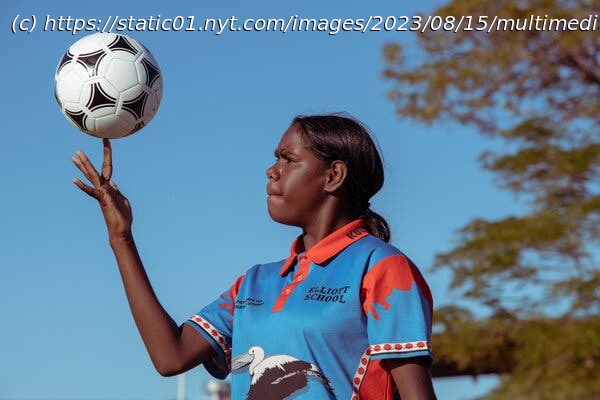In dusty Australian towns a thousand miles from the nearest Women’s World Cup stadium, Indigenous leaders hope the sport can offer hope, and opportunity.
They do not have marked soccer fields in Tennant Creek, a town in Australia’s Northern Territory, halfway across the continent from Sydney. So one morning last week, before nearly 100 kids arrived to play a round-robin tournament, three fields had to be laid out on a big grass oval with cones, flags and portable goals.
The children were bused in from schools all over the Barkly Region, a vast expanse of the outback that is about the size of Finland but has a population of only about 8,000 people. For some, the trip meant enduring long stretches on rutted dirt roads. One school brought 12 students, about one-third of its entire enrollment across. Another did not bring enough to field a team, so it borrowed two players from a nearby community whose families are part of the same Aboriginal language group.
Boys and girls of all different ages played games together. For two days, the sport that can be played anywhere enlivened a community where the separation from the Women’s World Cup’s main stage is more than just thousands of miles.
“It’s a real soccer carnival,” said Annastashia August, an 11-year-old from Tennant Creek who is Warumungu, the people who are the traditional custodians of the land where the town now sits.
Soccer is Annastashia’s favorite sport, but this was only the second soccer carnival in her town. Both events arose from the initiative of John Moriarty, the first Aboriginal Australian selected for a national soccer team, who hopes to use the sport to help improve outcomes for Indigenous children in remote communities.
The rights of Indigenous peoples was one of the social causes FIFA chose to highlight at this year’s World Cup. Tournament organizers have recognized Indigenous communities in Australia and New Zealand, the two host countries, through measures that include the use of traditional place names alongside the more common English ones for each host city; the flying of Indigenous flags at stadiums; and the performing of Welcome to Country ceremonies by representatives of the traditional owners of the land wherever events are held.
Moriarty, 86, a Yanyuwa man who was first named to an Australian national team in 1960, said these gestures were appreciated but that there needed to be “substance” behind them. He and the other members of Indigenous Football Australia, a council that supports his initiative, John Moriarty Football, have called for meaningful support of Indigenous-led grass-roots programs from soccer’s Australian and global governing bodies. John Moriarty Football says it has received less than 20,000 Australian dollars, or about $13,000, from its country’s soccer governing body, Football Australia, since Moriarty launched the program in 2012.
“If it wasn’t for programs like JMF, the pathways for children in Tennant Creek to get to elite football, let alone a World Cup tournament, would be nonexistent — an impossible dream,” Moriarty wrote in an email. “But the talent for football in the bush is deep and the potential for football to break the cycle of intergenerational disadvantage is huge.”
Football Australia pointed to the creation two years ago of its National Indigenous Advisory Group, which includes the Australia striker Kyah Simon, who is of Aboriginal descent, and said that its Legacy ’23 plan, created to continue growing the sport after the World Cup, includes financing for a First Nations competition in New South Wales.






